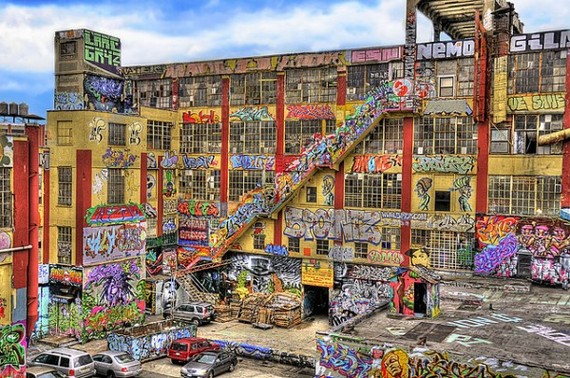On Wednesday, the U.S. District Court for the Eastern District of New York published its decision on the application for an injunction by a group of aerosol artists whose work appeared on 5Pointz against a group of defendants including Gerald Wolkoff, the primary owner of 5Pointz, to prevent the defendants from destroying 24 works of aerosol art that were on the buildings. Though the application for an injunction was denied on November 12, and whitewashing of the building began earlier this week, the decision details the judge's reason for denying the injunction, letting the case proceed to trial, and for the street artists who had created work on the site, it gives potential hope for other kinds of relief down the road.
Photo: Flickr via IamNigelMorris.
The case is noteworthy, not only because it centers around one of the city's best-loved and most-visited sites, but also because it represents the first time that a court has had to decide whether or not the work of an "exterior aerosol artist" is worthy of legal protection. Aerosol art and graffiti are distinguished by their legality: the former is done with permission (as the work was here) while the latter is illicit.
Starting in 2002, Wolkoff agreed to allow street artist Jonathan Cohen to begin curating aerosol art for the walls of the five-story building, which at that time housed several commercial businesses, to remedy the problem of the "distasteful" graffiti that had been covering the walls since the mid-1990s. Cohen, known in the art world as Meres One, and whose images of drunken light bulbs were some of the more well-known works on the site, was also one of the main street artists whose work would come to be identified with 5Pointz.
While the court acknowledged that the site had become a recognizable public attraction - bringing six to ten bus tours per day as well as school trips and VIP and corporate tours, not to mention foot and bike tours -- they left for a later date the decision over whether or not the works in question were worthy of protection.
The Visual Artists Rights Act of 1990 (VARA) protects against the destruction of visual art, but only if the artworks are of "recognized stature." Thus, in order to determine whether or not the works are worthy of protection, the court would need to decide whether or not the works were of "recognized stature" (a term not defined by VARA).
"The final resolution of whether any do indeed qualify as such works of art is best left for a fuller exploration of the merits after the case has been properly prepared for trial," said Justice Frederic Block in his opinion, "rather than at the preliminary injunction stage."
What swayed the court's decision not to grant a preliminary injunction was the "transient nature" of plaintiffs' works and the fact that there was plenty of evidence to show that Cohen knew the buildings would be demolished eventually.
"Regardless of Cohen's belief that the 24 works were to be permanently displayed on the buildings, he always knew that the buildings were coming down -- and that his paintings, as well as the others which he allowed to be placed on the walls, would be destroyed... In a very real sense, plaintiffs have created their own hardships."
In order for the court to have granted the preliminary injunction, it would have needed to decide that the plaintiffs would suffer "irreparable harm" if the aerosol paintings were destroyed. But it determined the plaintiffs would not suffer irreparable harm because there were other ways that they could be given restitution, like monetary damages.
Justice Block stated that paintings are meant to be sold and their value is tied to the money that people are willing to pay for them in the marketplace. The court acknowledged that VARA protects even temporary works (like some aerosol art) from destruction, and stated that the defendants may be "exposed to potentially significant monetary damages" should it ultimately be decided that the works in question were of "recognized stature." Justice Block also noted that Wolkoff benefited economically from all of the attention that the artwork had brought to the site and gave the street artists his blessing to paint on the walls without requiring them to sign VARA waivers, which would protect him from liability.
The new apartments that Wolkoff plans to build, as per the City Planning Commission's edict, will have 75 affordable housing units as well as 3,300 square feet of exterior space on the new structure that will be made available for a new permanent home for aerosol artists.
"Defendants can do even more," the court continued. "They can make more space available, and give written permission to Cohen to continue to be the curator so that he may establish a large, permanent home for quality work by him and his acclaimed aerosol artists. For sure, the Court would look kindly on such largesse when it might be required to consider the issue of monetary damages."
-Rozalia Jovanovic, ARTINFO
Like what you see? Sign up for ARTINFO's daily newsletter to get the latest on the market, emerging artists, auctions, galleries, museums, and more.
